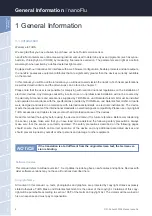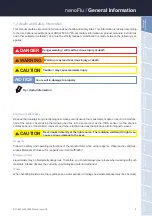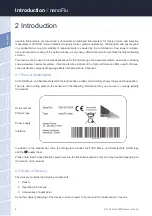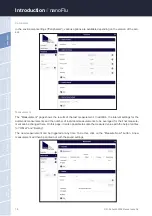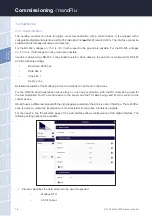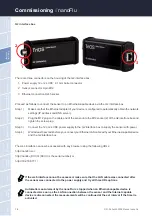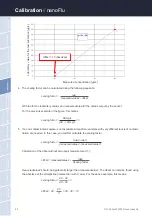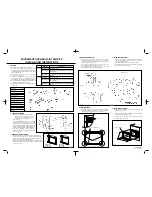
8
D01-060en202008 Manual nanoFlu
Use
Calibration
Malfunction &
Maintenance
Commis-
sioning
General
Information
FA
Q
Technical Data
W
arranty
Customer
Service
Contact
Keyword
Index
Accessories
Introduction
Introduction
//
nanoFlu
2.3.1 Fluorescence
Fluorescence is the spontaneous emission of light directly after a material has been excited. The emitted light is
generally lower in energy (larger wavelength) than the previously absorbed light (shorter wavelength).
Photons are absorbed and electrons of the molecule are lifted into an energetically higher orbital, i.e. excited. If
they fall back to their original level, the released energy produces heat and photons (fluorescent light).
Double-bond electrons are excited more easily, because the p-electrons of the double bond are distributed over
both atoms and are therefore not so strongly bound. Molecules with a conjugated double bond are particularly
suitable for fluorescence; the electrons are distributed over several atoms and are therefore very easy to excite.
2.3.2 Parameters
Depending on the parameters, nanoFlu uses different LEDs for long-term stable measurements of fluorescence
values. The following parameters (see table) can be measured or derived with nanoFlu.
Parameter
Excitation wavelength
Detection wavelength
Chl-a
470
682
blue
620
655
CDOM
360
460
2.4 Browser
nanoFlu is equipped with a web interface, which can be used to configure the sensor. To access the web inter
-
face, you will need the G2 interface box and an Ethernet-capable device with a web browser, e.g. a notebook.
Open one of the following URLs (depending on the network structure) in your web browser:
http://nanoFlu/ or
http:// nanoFlu _D2XX/ (D2XX is the serial number) or
http://192.168.77.1/
When connected to an Internet-capable device, automatic measurements will be stopped. As
soon as the sensor is disconnected from your device, the measurements will continue at the
set interval if the timer is activated for automatic measurements.
Summary of Contents for nanoFlu
Page 1: ...nanoFlu OPERATING INSTRUCTIONS ...
Page 2: ......




